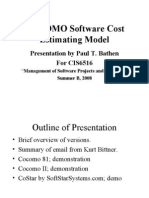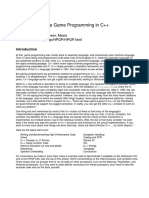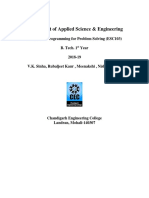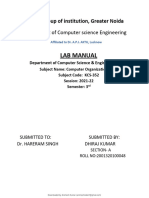Ultimate C Part 1 C Programming
Uploaded by
Ezekiel JamesUltimate C Part 1 C Programming
Uploaded by
Ezekiel JameslOMoARcPSD|13173261
Ultimate C Part 1 - C++ programming
Diploma in information communication technology (Mawego Technical Training Institute)
Studocu is not sponsored or endorsed by any college or university
Downloaded by Ezekiel James (jamesezekiel039@gmail.com)
lOMoARcPSD|13173261
The Ultimate
Part 1: The Fundamentals
Mosh Hamedani
Copyright 2022 Code with Mosh codewithmosh.com
codewithmosh.com
Downloaded by Ezekiel James (jamesezekiel039@gmail.com)
lOMoARcPSD|13173261
Hi! I am Mosh Hamedani. I’m a software engineer with over 20
years of experience and I’ve taught millions of people how to code
and become professional software engineers through my YouTube
channel and coding school (Code with Mosh).
This PDF is part of my Ultimate C++ course where you will learn
everything you need to know from the absolute basics to more
advanced concepts. You can find the full course on my website.
https://codewithmosh.com
https://www.youtube.com/c/programmingwithmosh
https://twitter.com/moshhamedani
https://www.facebook.com/programmingwithmosh/
Copyright 2022 Code with Mosh codewithmosh.com
Downloaded by Ezekiel James (jamesezekiel039@gmail.com)
lOMoARcPSD|13173261
Table of Content
Getting Started………………………………………………………………………………..4
The Basics……………………………………………………………………………………..6
Data Types…………………………………………………………………………………….8
Decision Making…………………………………………………………………………….11
Loops…………………………………………………………………………………………15
Functions…………………………………………………………………………………….17
Copyright 2022 Code with Mosh codewithmosh.com
Downloaded by Ezekiel James (jamesezekiel039@gmail.com)
lOMoARcPSD|13173261
Getting Started
Terms
C++ Standard Library Integrated Development Environment
Compiling Machine code
Console application Statement
Function Syntax
Graphical User Interface (GUI) Terminal
Summary
• C++ is one of the oldest yet most popular programming languages in the world due to
its performance and efficiency.
• It’s often used in building performance-critical applications, video games (especially
with Unreal Engine), servers, operating systems, etc.
• To learn C++, you need to learn the syntax (grammar) of the language as well as C++
Standard Library, which is a collection of pre-written C++ code for solving common
problems.
• To write C++ applications, we often use an Integrated Development Environment
(IDE). The most popular IDEs are MS Visual Studio, XCode, and CLion.
• To run C++ applications, first we have to compile our C++ code to machine code.
• The main() function is the starting point of a C++ program.
Copyright 2022 Code with Mosh codewithmosh.com
Downloaded by Ezekiel James (jamesezekiel039@gmail.com)
lOMoARcPSD|13173261
Your First C++ Program
Copyright 2022 Code with Mosh codewithmosh.com
Downloaded by Ezekiel James (jamesezekiel039@gmail.com)
lOMoARcPSD|13173261
The Basics 6
The Basics
Terms
Camel case Operator
Comment Pascal case
Constant Snake case
Directive Standard input stream
Expression Standard output stream
Hungarian notation Stream extraction operator
Mathematical expression Stream insertion operator
Operand Variable
Summary
• We use variables to temporarily store data in the computer’s memory.
• To declare a variable, we should specify its type and give it a meaningful name.
• We should initialize variables before using them. Using an uninitialized variable can
lead to unexpected behavior in our programs since these variables hold garbage values.
• Unlike variables, the value of constants don’t change.
• The common naming conventions used in C++ applications are: PascalCase,
camelCase, and snake_case.
• An expression is a piece of code that produces a value. A mathematical (arithmetic)
expression consists of an operator (+, -, *, /, %) and two operands.
• Multiplication and division operators have a higher priority than addition and
subtraction operators. So, they’re applied first.
Copyright 2022 Code with Mosh codewithmosh.com
Downloaded by Ezekiel James (jamesezekiel039@gmail.com)
lOMoARcPSD|13173261
The Basics 7
• We can use parentheses to change the order of operators.
• We use cout (pronounced sea-out) to write characters to the Standard Output Stream
which represents the terminal or console window.
• We use cin (pronounced sea-in) to read data from the Standard Input Stream which
represents the keyboard.
• We use the Stream Insertion Operator (<<) to write data to a stream.
• We use the Stream Extraction operator (>>) to read data from a stream.
• The Standard Template Library (STL) consists of several files each containing functions for
different purposes.
• To use functions in the Standard Library, we should include the corresponding files
using the #include directive.
• Using comments we can explain what cannot be expressed in code. This includes why’s,
how’s, and any assumptions we made while writing code.
Copyright 2022 Code with Mosh codewithmosh.com
Downloaded by Ezekiel James (jamesezekiel039@gmail.com)
lOMoARcPSD|13173261
Fundamental Data Types 8
Data Types
Terms
Array Floating-point number
Binary system Hexadecimal system
Boolean values Index
Casting Overflow
Characters Run-time error
Compile-time error Stream manipulator
Data type String
Decimal system Underflow
Summary
• C++ has several built-in data types for storing integers (whole numbers), floating-point
numbers (numbers with a decimal point), characters, and Boolean values (true/false).
• Floating-point numbers are interpreted as double by default. To represent a float, we
have to add the F suffix to our numbers (eg 1.2F).
• Whole numbers are interpreted as int by default. To represent a long, we have to use
the L suffix (eg 10L).
• Using the auto keyword, we can let the compiler infer the type of a variable based on its
initial value.
• Numbers can be represented using the decimal, binary, and hexadecimal systems.
• If we store a value larger or smaller than a data type’s limits, overflowing or underflowing
occurs.
Copyright 2022 Code with Mosh codewithmosh.com
Downloaded by Ezekiel James (jamesezekiel039@gmail.com)
lOMoARcPSD|13173261
Fundamental Data Types 9
• Using the sizeof() function, we can see the number of bytes taken by a data type.
• We can use stream manipulators to format data sent to a stream. The most common
manipulators are setw, fixed, setprecision, boolalpha, left, and right.
• The Boolean false is represented as 0. Any non-zero number is interpreted as the
Boolean true.
• In C++, characters should be surrounded with single quotes.
• Characters are internally represented as numbers.
• A string is a sequence of characters and should be surrounded by double quotes.
• We use arrays to store a sequence of items (eg numbers, characters, etc).
• Array elements can be accessed using an index. The index of the first element in an
array is 0.
• When we store a smaller value in a larger data type, the value gets automatically cast
(converted to) the larger type. When storing a large value in a smaller data type, we
have to explicit cast the value.
• C-style casting involves prefixing a variable with the target data type in parentheses. In
C++, we use the static_cast operator.
• C++ casting is safer because conversion problems can be caught at the compile-time.
With C-style casting, we won’t know about conversion issues until the run-time.
Copyright 2022 Code with Mosh codewithmosh.com
Downloaded by Ezekiel James (jamesezekiel039@gmail.com)
lOMoARcPSD|13173261
Fundamental Data Types 10
Copyright 2022 Code with Mosh codewithmosh.com
Downloaded by Ezekiel James (jamesezekiel039@gmail.com)
lOMoARcPSD|13173261
Decision Making 11
Decision Making
Terms
Boolean expression
Comparison operators
Conditional operator
If statement
Logical operators
Nesting if statements
Switch statement
Summary
• We use comparison operators to compare values.
• A Boolean expression is a piece of code that produces a Boolean value.
• With Logical operators we can combine Boolean expressions and represent more complex
conditions.
• With the logical AND operator (&&) both operands should be true. If either of them is
false, the result will be false.
• With the logical OR operator (||), the result is true if either of the operands is true.
• The logical NOT operator (!) reverses a Boolean value.
• Using if and switch statements, we can control the logic of our programs.
• An if statement can have zero or more else if clauses for evaluating additional
conditions.
Copyright 2022 Code with Mosh codewithmosh.com
Downloaded by Ezekiel James (jamesezekiel039@gmail.com)
lOMoARcPSD|13173261
Decision Making 12
• An if statement can optionally have an else clause.
• We can code an if statement within another. This is called nesting if statements.
• Using the conditional operator we can simplify many of the if/else statements.
• We use switch statements to compare a variable against different values.
• A switch block often has two or more case labels and optionally a default label.
• Case labels should be terminated with a break statement; otherwise, the control moves
to the following case label.
• Switch statements are not as flexible as if statements but sometimes they can make our
code easier to read.
Copyright 2022 Code with Mosh codewithmosh.com
Downloaded by Ezekiel James (jamesezekiel039@gmail.com)
lOMoARcPSD|13173261
Decision Making 13
Copyright 2022 Code with Mosh codewithmosh.com
Downloaded by Ezekiel James (jamesezekiel039@gmail.com)
lOMoARcPSD|13173261
Decision Making 14
Copyright 2022 Code with Mosh codewithmosh.com
Downloaded by Ezekiel James (jamesezekiel039@gmail.com)
lOMoARcPSD|13173261
Loops 15
Loops
Terms
Break statement Iteration
Continue statement Loops
Do-while statement Loop variable
For statement Nested loop
Infinite loop While statement
Summary
• We use loops to repeat a set of statements.
• In C++, we have four types of loops: for loops, range-based for loops, while loops, and
do-while loops.
• For loops are useful when we know ahead of time how many times we want to repeat
something.
• Range-based for loops are useful when iterating over a list of items (eg an array or a
string).
• While and do-while loops are often used when we don’t know ahead of time how
many times we need to repeat something.
• Using the break statement we can break out of a loop.
• Using the continue statement we can skip an iteration.
Copyright 2022 Code with Mosh codewithmosh.com
Downloaded by Ezekiel James (jamesezekiel039@gmail.com)
lOMoARcPSD|13173261
Loops 16
Copyright 2022 Code with Mosh codewithmosh.com
Downloaded by Ezekiel James (jamesezekiel039@gmail.com)
lOMoARcPSD|13173261
Functions 17
Functions
Terms
Debugging Function signature
Functions Global variables
Function arguments Invoking a function
Function declaration Header files
Function definition Local variables
Function parameters Namespaces
Function prototype Overloading functions
Summary
• A function is a group of one or more statements that perform a task. Each function
should have a clear responsibility. It should do one and only one thing.
• A function can have zero or more parameters
• Arguments are the values passed to a function.
• To call (or invoke) a function, we type its name, followed by parenthesis, and the
arguments (if any).
• Function parameters can have a default value. This way, we don’t have to provide
arguments for them.
• The signature of a function includes the function name, and the number, order, and type
of parameters.
Copyright 2022 Code with Mosh codewithmosh.com
Downloaded by Ezekiel James (jamesezekiel039@gmail.com)
lOMoARcPSD|13173261
Functions 18
• Overloading a function means creating another variation with a different signature. By
overloading functions, we can call our functions in different ways.
• Arguments of a function can be passed by value or reference. When passed by value,
they get copied to the parameters of the function.
• To pass an argument by a reference, we should add an & after the parameter type.
• Local variables are only accessible within the function in which they are defined. Global
variables are accessible to all functions.
• Global variables can lead to hard-to-detect bugs and should be avoided as much as
possible.
• A function declaration (also called a function prototype) tells the compiler about the
existence of a function with a given signature. A function definition (or implementation)
provides the actual body (or code) for the function.
• As our programs grow in more complexity, it becomes critical to split our code into
separate files.
• A header file ends with “.h” or “.hpp” extension and consists of function declarations
and constants. We can import header files using the #include directive.
• An implementation file ends with “.cpp” extension and consists of function definitions.
• Using namespaces we can prevent name collisions in our programs.
• Debugging is a technique for executing a program line by line and identifying potential
errors.
Copyright 2022 Code with Mosh codewithmosh.com
Downloaded by Ezekiel James (jamesezekiel039@gmail.com)
lOMoARcPSD|13173261
Functions 19
Copyright 2022 Code with Mosh codewithmosh.com
Downloaded by Ezekiel James (jamesezekiel039@gmail.com)
lOMoARcPSD|13173261
Functions 20
Copyright 2022 Code with Mosh codewithmosh.com
Downloaded by Ezekiel James (jamesezekiel039@gmail.com)
You might also like
- COCOMO Software Cost Estimating Model: Presentation by Paul T. Bathen For CIS6516No ratings yetCOCOMO Software Cost Estimating Model: Presentation by Paul T. Bathen For CIS651674 pages
- High Performance Game Programming in C++No ratings yetHigh Performance Game Programming in C++41 pages
- Security in Computing & Information Technology (COSC2536) : Lecture 2: More Concepts On CryptographyNo ratings yetSecurity in Computing & Information Technology (COSC2536) : Lecture 2: More Concepts On Cryptography36 pages
- Introduction To Computer Systems: The Course That Gives CMU Its "Zip"!No ratings yetIntroduction To Computer Systems: The Course That Gives CMU Its "Zip"!29 pages
- SP-Automatic Generation of Descriptive Comments for Code BlocksNo ratings yetSP-Automatic Generation of Descriptive Comments for Code Blocks8 pages
- JD Freshers Premier Hiring ( 2025 ) IIT's_NIT'sNo ratings yetJD Freshers Premier Hiring ( 2025 ) IIT's_NIT's7 pages
- BIT: A Very Compact Scheme System For MicrocontrollersNo ratings yetBIT: A Very Compact Scheme System For Microcontrollers36 pages
- Ahoy SAILR! There is No Need to DREAM of C: A Compiler-Aware Structuring Algorithm for Binary DecompilationNo ratings yetAhoy SAILR! There is No Need to DREAM of C: A Compiler-Aware Structuring Algorithm for Binary Decompilation18 pages
- Chapter1 - SDM Software Development MethodNo ratings yetChapter1 - SDM Software Development Method39 pages
- FALLSEM2022-23 SWE2007 ETH VL2022230101107 Reference Material I 20-07-2022 Module-1No ratings yetFALLSEM2022-23 SWE2007 ETH VL2022230101107 Reference Material I 20-07-2022 Module-1100 pages
- Cs3691 Embedded Systems and Iot Lab ManualNo ratings yetCs3691 Embedded Systems and Iot Lab Manual67 pages
- Simulink Coder 8.0: Generate C and C++ Code From Simulink and Stateflow ModelsNo ratings yetSimulink Coder 8.0: Generate C and C++ Code From Simulink and Stateflow Models6 pages
- The-complete-guide-to-speed-up-your-builds-v7No ratings yetThe-complete-guide-to-speed-up-your-builds-v724 pages
- Computer Organization and Assembly Language Lab Manual50% (2)Computer Organization and Assembly Language Lab Manual48 pages
- Computer Organization Architecture - PracticalNo ratings yetComputer Organization Architecture - Practical28 pages
- Modern CMake for C++: Effortlessly build cutting-edge C++ code and deliver high-quality solutionsFrom EverandModern CMake for C++: Effortlessly build cutting-edge C++ code and deliver high-quality solutionsNo ratings yet
- C++ Debugging from Scratch: A Practical Guide with ExamplesFrom EverandC++ Debugging from Scratch: A Practical Guide with ExamplesNo ratings yet
- C++ Regular Expressions Simplified: A Practical Guide with ExamplesFrom EverandC++ Regular Expressions Simplified: A Practical Guide with ExamplesNo ratings yet
- Getting Started With FastApi Here Continue Your Roadmap in The Development of Web Applications in Python With FastApi100% (1)Getting Started With FastApi Here Continue Your Roadmap in The Development of Web Applications in Python With FastApi155 pages
- Statistical Analysis of The Effect of Some MacroeconomicNo ratings yetStatistical Analysis of The Effect of Some Macroeconomic8 pages
- Data Structure MCQ (Multiple Choice Questions) - SanfoundryNo ratings yetData Structure MCQ (Multiple Choice Questions) - Sanfoundry15 pages
- Caltech - PGP - Full Stack Web Development - v4No ratings yetCaltech - PGP - Full Stack Web Development - v419 pages
- Manoj Regmi Intern Report For Mid DefenceNo ratings yetManoj Regmi Intern Report For Mid Defence27 pages
- SQL Server 2022 Revealed: A Hybrid Data Platform Powered by Security, Performance, and Availability 1st Edition Bob Ward - Download the full ebook version right now100% (2)SQL Server 2022 Revealed: A Hybrid Data Platform Powered by Security, Performance, and Availability 1st Edition Bob Ward - Download the full ebook version right now73 pages
- github-copilot-exam-preparation-study-guideNo ratings yetgithub-copilot-exam-preparation-study-guide8 pages
- Olsina Et Al. (2001) Specifying Quality Characteristics and Attributes For Websites. 3-540-45144-7 - 26No ratings yetOlsina Et Al. (2001) Specifying Quality Characteristics and Attributes For Websites. 3-540-45144-7 - 262 pages
- Oracle Primavera Global Price List Software Investment GuideNo ratings yetOracle Primavera Global Price List Software Investment Guide5 pages
- Chapter 2: IOS Images and Licensing: Scaling NetworksNo ratings yetChapter 2: IOS Images and Licensing: Scaling Networks33 pages
- How To Flash Samsung Stock Rom Using OdinNo ratings yetHow To Flash Samsung Stock Rom Using Odin11 pages
- Symmetrix Procedure Generator Information GuideNo ratings yetSymmetrix Procedure Generator Information Guide14 pages
- EPSON JavaPOS ADK Installation Guide For Linux100% (1)EPSON JavaPOS ADK Installation Guide For Linux4 pages
- Link To Publication in University of Groningen/UMCG Research DatabaseNo ratings yetLink To Publication in University of Groningen/UMCG Research Database21 pages
- Indu 411 Lecture 4: Product Design and Cad/Cam: Instructor: Dr. Amar Sabih, PengNo ratings yetIndu 411 Lecture 4: Product Design and Cad/Cam: Instructor: Dr. Amar Sabih, Peng35 pages
- Class 9 Computer Applications (Finals 20-21)No ratings yetClass 9 Computer Applications (Finals 20-21)5 pages
- QR Code Attendance Monitoring System With Sms Notification: Pamantsan NG Lungsod NG MarikinaNo ratings yetQR Code Attendance Monitoring System With Sms Notification: Pamantsan NG Lungsod NG Marikina6 pages
- Chapter Three Fundamentals of The C/C++ Programming LanguageNo ratings yetChapter Three Fundamentals of The C/C++ Programming Language23 pages
- COCOMO Software Cost Estimating Model: Presentation by Paul T. Bathen For CIS6516COCOMO Software Cost Estimating Model: Presentation by Paul T. Bathen For CIS6516
- Security in Computing & Information Technology (COSC2536) : Lecture 2: More Concepts On CryptographySecurity in Computing & Information Technology (COSC2536) : Lecture 2: More Concepts On Cryptography
- Introduction To Computer Systems: The Course That Gives CMU Its "Zip"!Introduction To Computer Systems: The Course That Gives CMU Its "Zip"!
- SP-Automatic Generation of Descriptive Comments for Code BlocksSP-Automatic Generation of Descriptive Comments for Code Blocks
- BIT: A Very Compact Scheme System For MicrocontrollersBIT: A Very Compact Scheme System For Microcontrollers
- Ahoy SAILR! There is No Need to DREAM of C: A Compiler-Aware Structuring Algorithm for Binary DecompilationAhoy SAILR! There is No Need to DREAM of C: A Compiler-Aware Structuring Algorithm for Binary Decompilation
- FALLSEM2022-23 SWE2007 ETH VL2022230101107 Reference Material I 20-07-2022 Module-1FALLSEM2022-23 SWE2007 ETH VL2022230101107 Reference Material I 20-07-2022 Module-1
- Simulink Coder 8.0: Generate C and C++ Code From Simulink and Stateflow ModelsSimulink Coder 8.0: Generate C and C++ Code From Simulink and Stateflow Models
- Computer Organization and Assembly Language Lab ManualComputer Organization and Assembly Language Lab Manual
- Modern CMake for C++: Effortlessly build cutting-edge C++ code and deliver high-quality solutionsFrom EverandModern CMake for C++: Effortlessly build cutting-edge C++ code and deliver high-quality solutions
- C++ Debugging from Scratch: A Practical Guide with ExamplesFrom EverandC++ Debugging from Scratch: A Practical Guide with Examples
- C++ Regular Expressions Simplified: A Practical Guide with ExamplesFrom EverandC++ Regular Expressions Simplified: A Practical Guide with Examples
- Getting Started With FastApi Here Continue Your Roadmap in The Development of Web Applications in Python With FastApiGetting Started With FastApi Here Continue Your Roadmap in The Development of Web Applications in Python With FastApi
- Statistical Analysis of The Effect of Some MacroeconomicStatistical Analysis of The Effect of Some Macroeconomic
- Data Structure MCQ (Multiple Choice Questions) - SanfoundryData Structure MCQ (Multiple Choice Questions) - Sanfoundry
- SQL Server 2022 Revealed: A Hybrid Data Platform Powered by Security, Performance, and Availability 1st Edition Bob Ward - Download the full ebook version right nowSQL Server 2022 Revealed: A Hybrid Data Platform Powered by Security, Performance, and Availability 1st Edition Bob Ward - Download the full ebook version right now
- Olsina Et Al. (2001) Specifying Quality Characteristics and Attributes For Websites. 3-540-45144-7 - 26Olsina Et Al. (2001) Specifying Quality Characteristics and Attributes For Websites. 3-540-45144-7 - 26
- Oracle Primavera Global Price List Software Investment GuideOracle Primavera Global Price List Software Investment Guide
- Chapter 2: IOS Images and Licensing: Scaling NetworksChapter 2: IOS Images and Licensing: Scaling Networks
- Link To Publication in University of Groningen/UMCG Research DatabaseLink To Publication in University of Groningen/UMCG Research Database
- Indu 411 Lecture 4: Product Design and Cad/Cam: Instructor: Dr. Amar Sabih, PengIndu 411 Lecture 4: Product Design and Cad/Cam: Instructor: Dr. Amar Sabih, Peng
- QR Code Attendance Monitoring System With Sms Notification: Pamantsan NG Lungsod NG MarikinaQR Code Attendance Monitoring System With Sms Notification: Pamantsan NG Lungsod NG Marikina
- Chapter Three Fundamentals of The C/C++ Programming LanguageChapter Three Fundamentals of The C/C++ Programming Language










































































































